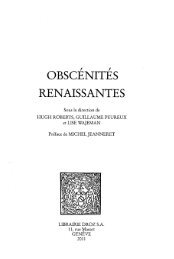Download (3398Kb) - ePrints Soton - University of Southampton
Download (3398Kb) - ePrints Soton - University of Southampton
Download (3398Kb) - ePrints Soton - University of Southampton
Create successful ePaper yourself
Turn your PDF publications into a flip-book with our unique Google optimized e-Paper software.
not an easy task to predict where larvae released at a particular location will go and<br />
how long the journey will take. As an example Campbell & Rowe (1997) described<br />
the new species <strong>of</strong> asteroid Patiriella paradoxa Campbell and Rowe, which being a<br />
temperate taxon inhabits southern Arabian waters. This fact could only be explained<br />
in terms <strong>of</strong> this species being a relict who evolved to survive continual conditions in<br />
this tropical location, supported by the influence <strong>of</strong> local seasonal upwelling.<br />
Fenaux et al. (1994) showed that in the Eastern Alborean Sea, where surface<br />
currents form a complex frontal zone, with associated eddies and gyres, the<br />
distributions <strong>of</strong> larvae and postlarvae <strong>of</strong> echinoderms vary according to hydro<br />
dynamic structures. Larvae are numerous in the Atlantic Geostrophic Jet, which<br />
passes along the African coast and they are accumulated in an anti-cyclonic gyre to<br />
the west <strong>of</strong> the jet. In the anti-cyclonic eddy <strong>of</strong> Mediterranean water, north <strong>of</strong> the<br />
frontal zone, the larvae by contrast were scarce.<br />
Wind forcing increases the effect <strong>of</strong> advection on larval transport and modifies<br />
significantly the level <strong>of</strong> larval retention. Wind-induced currents however, may<br />
produce larval transport from one population to another and might be involved in<br />
restoration <strong>of</strong> depleted populations (Ellien et al., 2000).<br />
Marsh et al. (2001) demonstrated the prevailing importance <strong>of</strong> current flow in<br />
determining dispersal potential <strong>of</strong> the tube worm Riftia pachyptila at deep-sea<br />
hydrothermal vents on the East Pacific Rise and suggested that populations at<br />
different vent sites may have different dispersal limits depending on local current<br />
conditions. In this region at least, it is apparent that the dispersal distance <strong>of</strong> R.<br />
pachyptila was not limited by the physiological performance <strong>of</strong> the larvae, but by<br />
temporal oscillations in the currents and larval loss in their flows.<br />
96
















